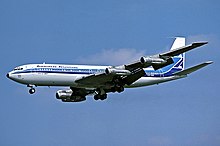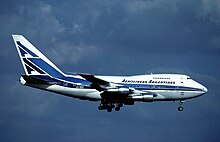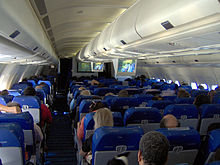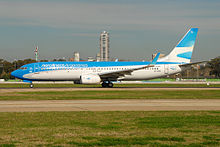Aerolíneas Argentinas
| Aerolíneas Argentinas | |
|---|---|

|
|

|
|
| IATA code : | AR |
| ICAO code : | ARG |
| Call sign : | ARGENTINA |
| Founding: | 1950 |
| Seat: |
Buenos Aires , Argentina |
| Turnstile : | |
| Home airport : | Buenos Aires-Ezeiza |
| Company form: | State company |
| IATA prefix code : | 044 |
| Management: | Luis Pablo Ceriani [1] |
| Number of employees: | approx. 8,000 |
| Alliance : | SkyTeam |
| Frequent Flyer Program : | Aerolíneas Plus |
| Fleet size: | 54 (+ 6 orders) |
| Aims: | National and international |
| Website: | www.aerolineas.com.ar |
Aerolíneas Argentinas is the largest Argentine airline based in Buenos Aires and based at the Buenos Aires-Ezeiza airport there . It is a member of the SkyTeam aviation alliance .
history
Foundation and first years

Aerolíneas Argentinas was founded on May 3, 1949 through a state-ordered merger of the four independent airlines: Flota Aérea Mercante Argentina (FAMA) , Aviación del Litoral Fluvial Argentino (ALFA) , Zonas Oeste y Norte de Aerolíneas Argentinas (ZONDA) and Aeroposta Argentina . ZONDA, ALFA and Aeroposta had set up a domestic network after the Second World War , while FAMA already flew routes to New York and Europe (Rome, Madrid). Since the domestic airlines flew in their assigned zones, there was little overlap in the combined route network of the Aerolíneas Argentinas. A greater challenge, however, was integrating the various types of aircraft. Even converted British Lancaster bombers were still on the way. Flying boats of the type Short Sandringham continued to be used for routes along the Río Paraná and Uruguay with the final destinations Asunción and Montevideo . The Convair CV- 240s ordered by ZONDA were soon used in Córdoba , Mendoza and Santiago de Chile . The now obsolete Douglas DC-3 maintained connections to rugged Patagonia . The more modern aircraft have not yet been able to land on the runways there. The intercontinental routes were flown by FAMA's Douglas DC-6 and DC-4 . Apart from a name change, the passengers here did not notice anything of the changes.
Only the Bolivian Santa Cruz de la Sierra was added to the route network as a new international destination in 1953 in cooperation with Lloyd Aéreo Boliviano . This route served by DC-4 was extended to Lima in 1954 .
The first jets



In 1955 Aerolíneas Argentinas got into a crisis after several air accidents. In addition, the new government that came to power after the coup against Juan Perón eased the barriers to entry for private airlines. Then several newcomers such as Transcontinental (TSA), Aerolíneas Ini and Transatlántica pushed onto the market and hit hard with their DC-4, DC-6 and Lockheed L-1049 Super Constellation of Aerolíneas Argentinas. But the state airline had the longer breath. In addition, the era of jet aircraft was looming on the horizon - the DC-6 and Constellations were not to compete with them in the long run.
On March 2, 1959, the first of six ordered De Havilland Comet 4s arrived, which Great Britain also supplied as reparations for the care of British soldiers during the Second World War . The first regular service took them on April 16, 1959 from Buenos Aires to Santiago de Chile - it was the first flight connection by aircraft with jet engines in South America . Soon the European destinations Rome , Frankfurt , Paris and London (with stopovers in Rio de Janeiro , Recife , Dakar and Madrid ) as well as New York were served with the new jet aircraft. But three machines were lost in accidents by 1962.
Nine Avro 748s and three Caravelle were ordered for the domestic network in 1961 . The French jets were used on the main domestic routes from 1962. After the Convairs and Sandringhams were decommissioned, the Aerolíneas Argentinas fleet now looked modern. On February 27, 1970, the airline received its first Boeing 737-200 .
Consolidation phase
In the early 1960s, pool agreements were concluded with Iberia , Alitalia and Panair do Brasil . At the same time, the three private Argentine airlines gave up operations and Aerolíneas Argentinas took over the traffic rights for Europe from Aerolíneas Ini . After another change of management, the airline had to tackle the next fleet modernization, because the competition was already using larger models than the Comet. Boeing was able to secure the order for four machines in 1965 with its 707-320B model. She flew for the first time on December 15, 1966 from Buenos Aires to New York. Soon afterwards they also flew to Europe, the section Rio de Janeiro - Rome being the longest non-stop connection in the world at the time (the stopover in Dakar was no longer necessary).
In Germany, the robust Avro 748 fan guns now met the jet-powered BAC 1-11 of the Austral Líneas Aéreas and Aerolíneas Argentinas ordered six Boeing 737-200s in 1967 . An agreement was reached with Austral in 1971 and the domestic traffic was divided among each other. Also Boeing 727-200 and Fokker 28-4000 came used.
In 1975 Aerolíneas Argentinas chose the Boeing 747-200 as its future wide-body aircraft , but the first own order was only announced in 1979 for three aircraft. From 1977, however, a plane rented by Boeing was on the way for the Argentines. With it, and the shorter special version SP and the Boeing 707, Aerolíneas Argentinas was the first airline to fly regularly over Antarctica from the early 1980s .
privatization

The military dictatorship in force from 1976 onwards hit the airline hard economically. The 1982 Falklands War made this worse. The government, which was again democratic from 1983, wanted to sell 40% of the shares to the Scandinavian SAS for restructuring , but the opposition thwarted this. The next candidate was the Spanish Iberia , which, however, already needed state funds to survive. The European Commission prohibited the sale of 80% of the shares to the Spaniards. After further sales attempts to the Brazilian VASP , Continental Airlines and American Airlines , the Interinvest holding was finally created in 1991, in which Iberia also held 30%. Interinvest also controlled Austral Líneas Aéreas. In 1995 Iberia increased its share to 83% and introduced a new paint scheme based on the color scheme of the Iberia machines. But just two years later, the Spaniards had to give the Argentines more control again.
On the fleet side, more modern McDonnell Douglas MD-88s were placed alongside the Boeing 737-200s domestically . For the market segment below the Boeing 747-200 , the decision was made for the Airbus A310-300 and in 1994 three machines were rented from the manufacturer.
Another crisis

In 1998, AMR, the parent company of American Airlines, took a 10% stake in Interinvest. Senior managers were sent to get the Argentine airline back on track, as the Aerolíneas Argentinas was mainly kept alive by the Spanish. The company should merge with Austral and the abolished European services should be revived. A more cost-efficient fleet should also be purchased. The new management opted for the Airbus A340 and ordered twelve aircraft, including six used aircraft that were returned by Philippine Airlines because of the Asian crisis .
After almost two years, the Americans gave up, the Spanish state holding Sociedad Estatal de Participaciones Industriales (SEPI) contributed around 800 million US dollars to survival and took over the helm. The multi-million dollar image campaign initiated and the merger with Austral was stopped. But nothing helped - in the spring of 2001 Aerolíneas Argentinas was again on the verge of collapse. All international services were discontinued and SEPI sold its shares to the Spanish Grupo Marsans , which also controlled Air Comet . Flights to the USA, Brazil, Madrid, Auckland and Sydney have resumed. Several McDonnell Douglas MD-80s were relocated to Madrid and served Paris and London from here. Later they also cooperated with Air Plus Comet and used their Airbus A310-300 and Boeing 737-300 for flights to Athens , Milan , Munich and Zurich .
Development from 2005
At the end of November 2005, the pilots of Aerolíneas Argentinas went on strike, which ended on December 4, 2005. After mediation by the Argentine and Spanish governments, the company gave in and agreed to a wage increase. It was also agreed that 373 workers who had been laid off due to the strike should be reinstated immediately. 600 flights were canceled during the nine-day strike. Around 100,000 passengers were affected. New terms should be agreed within the next 90 days.
After the previous president of the company, Antonio Mata, resigned in mid-2006 under pressure from the government and unions, the situation in society normalized somewhat.
At the end of September 2006, investments were announced for the next three years, revising the previous decision to renew or expand the fleet with aircraft from the manufacturer Boeing . Instead, it was now planned to purchase several A340-200, A330-200 and A320-200 from Airbus , while the Boeing fleet was only to be increased by a fourth 747-400. However, the MD-80 fleet, which was now operated exclusively by Austral, was to be increased by 50 percent to 21 aircraft. On October 11, 2006, Grupo Marsans announced a letter of intent to purchase 61 aircraft from Airbus (ten Airbus A350-900s , four A380-800s , five A330-200s and 42 aircraft from the A320 family ). However, this intention was ultimately not converted into sales contracts.
Nationalization in 2008
Due to the indebtedness of the Marsans group, it was decided on July 17, 2008 to re-nationalize the airline. The shares of the previous owners were gradually taken over by the Argentine state over the course of the year.
On March 5th, Aerolíneas Argentinas signed an agreement with the Israeli airline El Al . Were planned codeshare flights via Sao Paulo and Europe to the Middle East. Since April 6, Aerolíneas Argentinas has also had an agreement with the Chilean Sky Airline on the routes between Argentina, Chile and Peru . Sky Airline's flights to destinations include Punta Arenas and Antofagasta .
present
On August 29, 2012, Aerolineas Argentinas joined the international aviation alliance SkyTeam . The first codeshare agreement was signed with Delta Air Lines , followed on November 1, 2011 by another with Air France and its sister company KLM Royal Dutch Airlines .
On February 1, 2012, Aerolineas Argentinas decommissioned its last Boeing 747-400 . In April 2012, she also decommissioned her remaining McDonnell Douglas MD-80 fleet , which was successively replaced by Boeing 737s .
In August 2013, Aerolineas Argentinas took over their first Airbus A330-200 , which replaced the old A340-200 by August 2014. In the course of this, after a five-year break, New York City was served again from December 2013 .
In February, Aerolineas Argentinas ordered four more Airbus A330-200s, after having previously considered buying a Boeing 787 .
When the government changed on December 10, 2015, the former GM regional president for Argentina, Uruguay and Paraguay Isela Costantini replaced the previous CEO Mariano Recalde and filled the post until the end of summer 2018, followed by Luis Malvido.
In December 2018, it was announced that the company needed $ 200 million in subsidies for the current year. The reasons for this are higher fuel costs, falling prices for domestic flights after the government partially abolished an artificial lower limit for domestic flights in the summer and the rising inflation of the peso (a large part of the company's costs is to be paid in dollars). In addition, part of the workforce went on strike at the beginning of December and the company had to negotiate with around six different unions. The government has ruled out privatization or dismissal of the workforce.
In May 2020 it was announced that Aerolíneas Argentinas will merge with the airline Austral Líneas Aéreas by the end of 2020. You are already part of the same group.
Destinations
Together with the subsidiary Austral Líneas Aéreas , Aerolíneas Argentinas offers a tightly knit domestic network that extends from the Gran Chaco region in the north, a hot dry savannah , to the rough and sparsely populated Patagonia in the far south. Since the domestic route network of Aerolíneas and its subsidiary is star-shaped and oriented towards Buenos Aires, each destination is served either from the regional airport Jorge Newbery or from the international airport Ezeiza . In addition, some important Argentine destinations are also connected with each other, so there are now numerous flight connections from Cordóba or Rosario .
The main international destinations of Aerolíneas Argentinas are Rome , Madrid , Miami , New York , Rio de Janeiro , São Paulo , Santiago de Chile , Bogotá .
Code sharing
Aerolineas Argentinas currently has code-share agreements with the following airlines: Aeroméxico , Aeroflot , Air Europa , Air France , Air New Zealand , Delta Air Lines , Etihad Airways , KLM Royal Dutch Airlines , Gol Linhas Aéreas , Alitalia , Korean Air , El Al and China Eastern Airlines .
fleet
Current fleet
As of May 2020, the Aerolíneas Argentinas fleet consists of 54 aircraft with an average age of 8.0 years:
| Aircraft type | active | ordered | Remarks | Seats ( Business / Economy ) |
Average age
(May 2020) |
|---|---|---|---|---|---|
| Airbus A330-200 | 10 | more A330s are to be added to the fleet [2] | 272 (24/248) | 13.0 years | |
| Airbus A330-200F | 2 | are to be floated by 2022 [3] | |||
| Boeing 737-700 | 8th | Equipped with winglets , they are being phased out successively | 128 (8/120) | 13.1 years | |
| Boeing 737-800 | 31 | equipped with winglets | 170 (8/162) | 6.0 years | |
| Boeing 737 MAX 8 | 5 | 6th | Launch customer in South America; all inactive | 2.3 years | |
| total | 54 | 8th | 8.0 years | ||
The regional subsidiary Austral Líneas Aéreas also operates its own fleet consisting of 26 Embraer 190 machines .
Former aircraft types
In the past, Aerolíneas Argentinas also used the following types of aircraft:
- Airbus A310
- Airbus A320
- Airbus A340 -200
- Airbus A340-300
- Boeing 707
- Boeing 727-200
- Boeing 737-300
- Boeing 737-200
- Boeing 737-500
- Boeing 747-200
- Boeing 747-400
- Boeing 747SP
- Convair CV-240
- De Havilland DH.106 Comet
- Douglas DC-3
- Douglas DC-4
- Douglas DC-6
- Fokker F28 Fellowship
- Hawker-Siddeley HS 748
- McDonnell Douglas MD-88
- NAMC YS-11
- Sud Aviation Caravelle
Incidents
From 1950 to May 2020, Aerolíneas Argentinas suffered 32 total losses of aircraft. In 14 of them 340 people were killed. Examples:
- On July 16, 1956, the approach of a Douglas DC-3 of Aerolineas Argentinas ( aircraft registration LV-ACD ) on the airport of Rio Cuarto was continued below the decision height; the machine was flown into the ground . All 18 people on board died.
- On December 8, 1957, a Douglas DC-4 of Aerolíneas Argentinas (LV-AHZ) broke up 20 kilometers southwest of Bolivar ( Province of Buenos Aires , Argentina) after being caught in a thunderstorm, the strong turbulence of which led to the Operating limits of the machine. All 61 occupants died (see also Aerolíneas Argentinas flight 670 ) .
- On September 7, 1960, on a Douglas DC-6 of Aerolíneas Argentinas (LV-ADS) , with which a flight from Asunción in Paraguay to Buenos Aires was carried out, the propeller of engine no. 3 tore off. The machine then broke apart in the air and crashed into a field near Salto in Uruguay . All 31 occupants were killed (see also Aerolíneas Argentinas flight 205 ) .
- On July 19, 1961, a Douglas DC-6 of Aerolíneas Argentinas (LV-ADW) broke apart 12 kilometers west of Pardo ( Province of Buenos Aires , Argentina) during a climb due to strong turbulence at an altitude of 4800 m. All 67 occupants died (see also Aerolíneas Argentinas flight 644 ) .
- On August 30, 1962, the left rear cabin door was torn out in the flight of an Avro 748 of Aerolíneas Argentinas (LV-HHB) . A flight attendant was killed after being sucked out of the machine by explosive decompression . It was the first fatal incident involving an aircraft of this type. (see also Aerolíneas Argentinas flight 737 ) .
See also
Web links
Individual evidence
- ↑ Anuncian oficialmente el traspaso de Aerolíneas Argentinas a manos del Estado , Clarin.com , 17. July 2008
- ↑ adn.es - Aerolíneas Argentinas inicia negociación de acuerdo con israelí El Al
- ↑ airliners.net - Aerolineas Argentinas Reaches Agreement with Sky Airline
- ↑ Aerolíneas Argentinas Joins SkyTeam ( memento of August 29, 2012 in the Internet Archive ), Skyteam, August 29, 2012
- ↑ DELTA / Aerolineas Argentinas Applies for Codeshare Service
- ↑ telam.com.ar - Aerolíneas firmó un acuerdo de código compartido con Air France y KLM ( Memento of November 4, 2011 in the Internet Archive ) (Spanish) November 1, 2011
- ↑ Picture of the Boeing 747-475 aircraft. Airliners.net, accessed on August 12, 2012 .
- ↑ flightlevel360.wordpress.com - OTRO A340-200 MÁS QUE DEVUELVE AEROLÍNEAS ARGENTINAS, August 22, 2014
- ↑ Aerolíneas Argentinas relanza los vuelos hacia Nueva York lanoticia1.com of July 24, 2013 (Spanish)
- ↑ airliners.de - Aerolineas Argentinas orders Airbus A330-200, February 13, 2014
- ↑ seattlepi.com - Report: Aerolineas Argentinas eyeing Boeing 787 order, February 19, 2010
- ↑ Taos Turner: Regional GM President Tapped to Head Aerolineas Argentinas. Wall Street Journal, November 30, 2015, accessed December 2, 2015 .
- ↑ Aerolíneas Argentinas senses privatization pressure, aero.de, November 15, 2018
- ↑ Aerolineas Argentinas “practically broke” , accessed on December 3, 2018
- ↑ Aerolineas Argentinas and Austral are merged. In: aeroTELEGRAPH. May 7, 2020, accessed on May 7, 2020 (Swiss Standard German).
- ↑ Aeroméxico volará con Aerolíneas Argentinas en código compartido In: reportur.com , accessed on August 18, 2017.
- ↑ Comunicados de prensa 2016. Aerolineas.com, September 16, 2016, accessed September 30, 2016 (Spanish).
- ↑ Aerolineas Argentinas / Etihad begins codeshare service from Aug 2017 In: routesonline.com , accessed on August 18, 2017.
- ↑ Alitalia / Aerolineas Argentinas begins codeshare service from late-May 2017 In: routesonline.com , accessed on August 18, 2017.
- ↑ koreanairpr.wordpress.com - Korean Air and Aerolineas Argentinas' first codeshare flights link Seoul and Buenos Aires (English)
- ↑ Argentina
- ↑ a b c d Aerolineas Argentinas Fleet Details and History. In: planespotters.net. May 5, 2020, accessed on May 7, 2020 .
- ↑ Boeing : Customer Summary Through July 2015 (English), accessed December 2, 2016
- ↑ Airbus : Orders & deliveries , accessed on December 2, 2016
- ↑ aerolineas.com - Fleet (English) accessed on May 30, 2015
- ↑ Ghim-Lay Yeo: Aerolineas to phase out A340s by end-2018. In: FlightGlobal.com. November 14, 2016, accessed November 17, 2016 .
- ↑ Reuters , notification from December 19, 2016.
- ^ Ulrich Klee, Frank Bucher et al .: jp airline-fleets international . Zurich Airport 1967–2007.
- ^ Ulrich Klee, Frank Bucher et al .: jp airline-fleets international . Sutton, UK, 2008-2013.
- ↑ Accident statistics Aerolíneas Argentinas , Aviation Safety Network (English), accessed on May 7, 2020.
- ^ Accident report DC-3 LV-ACD , Aviation Safety Network (English), accessed on August 20, 2017.
- ^ Accident report DC-4 LV-AHZ , Aviation Safety Network (English), accessed on February 16, 2020.
- ^ Accident report DC-6 LV-ADS , Aviation Safety Network (English), accessed on February 16, 2020.
- ^ Accident report DC-6 LV-ADW , Aviation Safety Network (English), accessed on February 16, 2020.
- ^ Accident report HS-748 LV-HHB , Aviation Safety Network (English), accessed on August 29, 2019.





